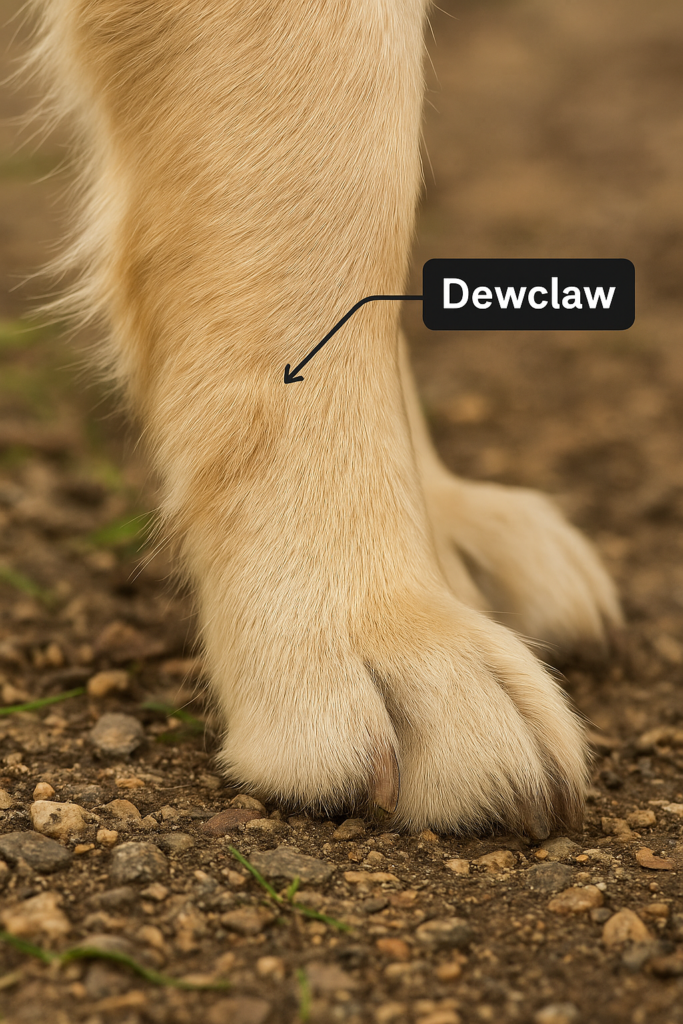Meta Description:
Dewclaws are often misunderstood, but they play an important role in your dog’s anatomy. Discover what dewclaws are, why dogs have them, and whether they should be removed.

🐾 What Are Dewclaws on a Dog?
Dewclaws are the small, thumb-like claws located higher up on a dog’s front or rear legs—often appearing to be “floating” above the paw. Unlike the other claws that touch the ground when the dog walks, dewclaws are rarely in contact with the surface.
Most dogs have dewclaws on their front legs, and some breeds also have them on the hind legs, either singly or in pairs.
🧬 Why Do Dogs Have Dewclaws?
Dewclaws are believed to be evolutionary remnants—similar to a human’s thumb or big toe. Despite common belief, dewclaws aren’t useless. In fact, they serve several important functions:
✅ Front Dewclaws Help with:
- Grip and stability when running at high speeds
- Climbing out of water
- Holding onto objects like bones or toys
- Maintaining balance during sharp turns
In working breeds like Border Collies, Labradors, or Great Pyrenees, dewclaws can actually help enhance performance and agility.
❓Should Dewclaws Be Removed?
The topic of dewclaw removal is a controversial one among dog owners, breeders, and vets.
🟢 When Removal May Be Recommended:
- If the dewclaws are loose or poorly attached, making them prone to injury
- In certain dog sports where they can easily snag
- For rear dewclaws, which are less functional and more prone to trauma
🔴 When Removal Is Not Necessary:
- If the dewclaws are healthy and functional
- If the dog uses them regularly for grip or movement
- If removal is purely cosmetic, most vets recommend leaving them intact
Always consult your veterinarian before deciding to remove a dog’s dewclaws. In some countries, unnecessary removal is even considered unethical or illegal.
🐶 Do All Dogs Have Dewclaws?
No, not all dogs have dewclaws. Here’s how it breaks down:
| Leg Type | Dewclaws Present? |
|---|---|
| Front Legs | Most dogs have them |
| Rear Legs | Some breeds may have them or double dewclaws (e.g., Great Pyrenees, Briards) |
Some breeds are even required to have dewclaws as part of their breed standard, especially in herding and guardian breeds.
🛠️ How to Care for Your Dog’s Dewclaws
Because dewclaws don’t get worn down through walking like other nails, they can grow quickly and curl inward, potentially causing pain or infection.
✂️ Tips for Dewclaw Maintenance:
- Trim regularly (every 2–4 weeks)
- Check for signs of cracking, bleeding, or infection
- Make it part of your grooming routine
Final Thoughts: Dewclaws Deserve More Respect!
So, what the heck are dewclaws? They’re more than just “extra claws”—they’re a functional part of your dog’s anatomy that can help with movement, grip, and stability.
Whether you choose to keep them or remove them, understanding dewclaws means you’re taking one more step toward being a better dog parent. 🐾

Leave a Reply